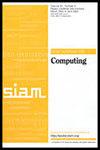Bridging the Gap Between Tree and Connectivity Augmentation: Unified and Stronger Approaches
IF 1.6
3区 计算机科学
Q3 COMPUTER SCIENCE, THEORY & METHODS
引用次数: 0
Abstract
We consider the connectivity augmentation problem (CAP), a classical problem in the area of survivable network design. It is about increasing the edge-connectivity of a graph by one unit in the cheapest possible way. More precisely, given a -edge-connected graph and a set of extra edges, the task is to find a minimum cardinality subset of extra edges whose addition to makes the graph -edge-connected. If is odd, the problem is known to reduce to the tree augmentation problem (TAP)—i.e., is a spanning tree—for which significant progress has been achieved recently, leading to approximation factors below 1.5 (the current best factor is 1.458). However, advances on TAP have not carried over to CAP so far. Indeed, only very recently, Byrka, Grandoni, and Ameli [Proceedings of the 52nd ACM Symposium on Theory of Computing, 2020, pp. 815–825] managed to obtain the first approximation factor below 2 for CAP by presenting a 1.91-approximation algorithm based on a method that is disjoint from recent advances for TAP. We first bridge the gap between TAP and CAP by presenting techniques that allow for leveraging insights and methods from TAP to approach CAP. We then introduce a new way to get approximation factors below 1.5, based on a new analysis technique. Through these ingredients, we obtain a 1.393-approximation algorithm for CAP, and therefore also for TAP. This leads to the current best approximation result for both problems in a unified way, by significantly improving on the abovementioned 1.91-approximation for CAP and also the previously best approximation factor of 1.458 for TAP by Grandoni, Kalaitzis, and Zenklusen [Proceedings of the 50th ACM Symposium on Theory of Computing, 2018, pp. 632–645]. Additionally, a feature we inherit from recent TAP advances is that our approach can deal with the weighted setting when the ratio of the largest to smallest cost on extra links is bounded, in which case we obtain approximation factors below 1.5.弥合树和连接性增强之间的差距:统一和更强大的方法
本文研究了可生存网络设计领域的一个经典问题——连通性增强问题。它是关于以最便宜的方式将图的边连通性增加一个单位。更准确地说,给定一个无边连通的图和一组额外的边,任务是找到一个最小的额外边的基数子集,这些额外边的加法使图具有无边连通。如果是奇数,则已知问题可简化为树增强问题(TAP) -即。,是一个生成树,最近取得了重大进展,导致近似因子低于1.5(目前最好的因子是1.458)。然而,到目前为止,TAP的预付款尚未结转到CAP。事实上,直到最近,Byrka, Grandoni和Ameli[第52届ACM计算理论研讨会论文集,2020年,第815-825页]通过提出基于与TAP最新进展脱节的方法的1.91近似算法,成功地获得了CAP低于2的第一个近似因子。我们首先通过介绍允许利用TAP的见解和方法来接近CAP的技术,弥合了TAP和CAP之间的差距。然后,我们引入了一种基于新的分析技术的新方法,以获得低于1.5的近似因子。通过这些成分,我们得到了CAP的1.393近似算法,因此也得到了TAP的1.393近似算法。通过显著改进上述CAP的1.91近似值,以及之前由Grandoni、Kalaitzis和Zenklusen提出的TAP的1.458的最佳近似值,从而以统一的方式得出了当前两个问题的最佳近似值[第50届ACM计算理论研讨会论文集,2018,pp. 632-645]。此外,我们从最近的TAP进展中继承的一个特征是,我们的方法可以处理当额外链路上的最大与最小成本之比有界时的加权设置,在这种情况下,我们获得的近似因子低于1.5。
本文章由计算机程序翻译,如有差异,请以英文原文为准。
求助全文
约1分钟内获得全文
求助全文
来源期刊

SIAM Journal on Computing
工程技术-计算机:理论方法
CiteScore
4.60
自引率
0.00%
发文量
68
审稿时长
6-12 weeks
期刊介绍:
The SIAM Journal on Computing aims to provide coverage of the most significant work going on in the mathematical and formal aspects of computer science and nonnumerical computing. Submissions must be clearly written and make a significant technical contribution. Topics include but are not limited to analysis and design of algorithms, algorithmic game theory, data structures, computational complexity, computational algebra, computational aspects of combinatorics and graph theory, computational biology, computational geometry, computational robotics, the mathematical aspects of programming languages, artificial intelligence, computational learning, databases, information retrieval, cryptography, networks, distributed computing, parallel algorithms, and computer architecture.
 求助内容:
求助内容: 应助结果提醒方式:
应助结果提醒方式:


